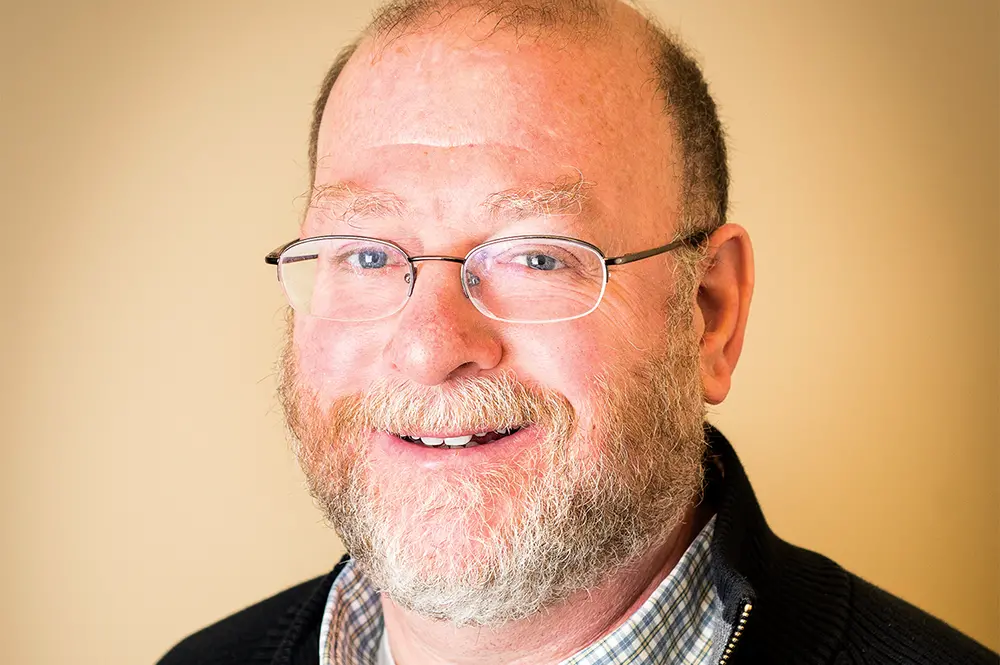

In 1906, the German psychiatrist Alois Alzheimer first identified amyloid plaque and neurofibrillary tangles in the brain samples of a deceased woman who had suffered severe memory loss. Today, amyloid plaque and tangles are still indicators of what is now called Alzheimer’s disease—the most common form of dementia—but how they act in the brain remains a mystery 113 years later.
Howard Aizenstein (BS, ’86, mathematics; MS, ’88; PhD, ’93, computer science; MD ’95) is a psychiatrist at the University of Pittsburgh, and he is helping to unravel this mystery through groundbreaking neuroimaging work.
Aizenstein and his colleagues at Pitt were among the first to measure amyloid plaque in living patients. One of their first papers on living patients showed that 20 percent of adults who didn’t show any signs of dementia surprisingly had a significant amount of amyloid plaque in the brain.
Despite these findings, he said, “Amyloid plaque is obviously a huge risk factor. But can someone go 20 years with amyloid plaque in the brain and not get dementia? Possibly.”
In addition to the work on dementia, Aizenstein uses neuroimaging to explore depression in older adults. For this pioneering work, he is a winner of the 2019 LAS Alumni Achievement Award.
Growing up in Skokie, Illinois, Aizenstein was always fascinated by math. But he was also intrigued by computers because his high school years fell in the midst of the personal computing revolution. His father owned a Radio Shack TRS-80 and let him play with the machine to program games.
In addition to math and computers, he had yet another interest—medicine. His father was a doctor, and he said, “I felt a pull to be a physician.”
The University of Illinois allowed him to satisfy all three passions because LAS offered a combined math and computer science degree, and he also majored in biology with medicine in mind. Aizenstein received his dual bachelor’s degree in 1986 and then continued on with his graduate work at Illinois.
In fact, Aizenstein is one of those rare academicians who received all of his degrees at the same place. He got his master’s in computer science in 1988, his PhD in computer science in 1993, and his MD in 1995—all from the U of I.
“I spent 13 years in this community, and I loved it,” he said. “I found Illinois to be an idyllic academic community. I’d sit and read on the quad, visit with friends, and talk about ideas.”
Aizenstein became fascinated with psychiatry while doing his medical school rotations. “It happened during the patient interviews, especially with older adults,” he said. “When I started talking with them about the problem that brought them to the hospital, I became interested in their mental processes.”
Conducting psychiatric interviews “fit both sides of my personality,” he explains. “It fit the computer science interest in information processing, understanding how people think. But it also has an empathy side, listening to people and understanding their problems.
“I think hearing people’s life story is fascinating,” he adds. “Older adults tend to be underappreciated, and I’m drawn to that.”
At Illinois, he said he also had many supportive faculty members, including his “most amazing” PhD adviser—Leonard Pitt, a computer science professor. The name “Pitt” turned out to be ironically prophetic because Aizenstein went on to spend his entire career at the University of Pittsburgh, or “Pitt.”
Aizenstein decided to specialize in geriatric psychiatry, but he said he was challenged to find a way to combine his computer science background and his MD. So he started doing computer modeling of psychiatric conditions—something that the University of Pittsburgh Medical Center (UPMC) was known for.
It turned out that this was a hot time for neuroimaging, so he used his computer science background to develop algorithms that analyzed functional MRI data on depression and dementia among older adults. His team demonstrated that vascular changes in the brain in older adults can contribute to depression.
“As one ages, there’s a breakdown in small vessels in the cardiovascular and cerebrovascular systems,” he said. Using fMRI, they were able to spot these “small, silent changes,” primarily in the brain’s white matter. Aizenstein’s lab found that vascular changes, even when they are not identified as clinical strokes, can contribute to depression in older adults. What’s more, depression can contribute to some of the cerebrovascular changes, so the two problems feed off of each other.
Aizenstein’s team also gained a greater understanding of how medications affect the brains of older adults suffering from depression. One of the challenges of giving antidepressants to patients is the long delay before they see any clinical response. Aizenstein found this to be a greater problem with older adults; it can take up to six weeks to know if an antidepressant is working, but by that time some people will drop out of care or stop treatment, without finding a medication that will help.
Aizenstein’s lab used fMRI to look at the brain 12 hours before and 12 hours after someone started an antidepressant. By looking at differences in the two scans, they can predict which patient is going to respond to medication. This scanning method is not yet FDA approved, but it is going through a larger, confirmatory study, which should be complete in three years.
In another study on the aging brain, Aizenstein’s team found that older individuals with no signs of dementia, despite having amyloid plaque in the brain, show increased activity in the hippocampus—the part of the brain tied to memory. This increased activity in the hippocampus could be compensating for the amyloid plaque. It could also be an indicator that tells physicians which patients might not be as likely to get dementia, despite the amyloid plaque.
“But we’re not there yet,” he said.
Today, Aizenstein is director of UPMC’s Geriatric Psychiatry Neuroimaging Lab, and he is active in three areas—research, teaching, and clinical work. The majority of his time is in research, but he said he loves seeing patients and training postdocs in geriatric mental health. He recently began managing a new training program for PhD students in bioengineering, while also mentoring one of the PhD students and co-mentoring several others.
Meanwhile, he remains active physically—one the most common ways to ward off mental impairments as we age. He bicycles, swims, and kayaks in the Pittsburgh area, with its abundance of rivers.
According to Aizenstein, “As one of my colleagues likes to say, the goal is to have people dancing until the end. So, stay actively engaged.”


